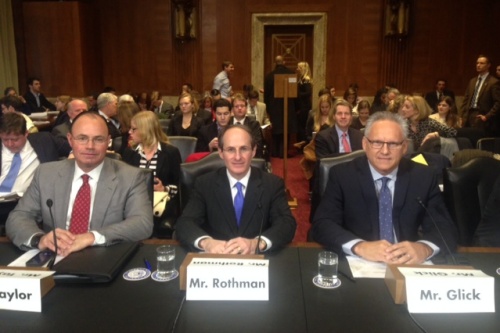On Wednesday, February 12, 2014, State Energy Officials from Hawaii, Minnesota, and Texas testified before the Senate Energy and Natural Resources Committee’s Subcommittee on Energy on their pioneering energy efficiency and renewable energy programs. Subcommittee Chairman Al Franken (D-MN) called the hearing to consider lessons for federal policy from state leadership in energy. In his video address during the recent NASEO Energy Outlook Conference, Senator Franken expressed his interest in learning from the states, emphasizing that states are leading the way to a clean energy future.
Mark Glick, State Energy Administrator in the Hawaii Department of Business, Economic Development, and Tourism, highlighted Hawaii’s Clean Energy Initiative—a bold energy policy developed by the state and implemented through an MOU with the U.S. Department of Energy (DOE). Hawaii’s policies, he said, are designed to transform the most oil dependent state into a national model for job creation, industrial transformation, environmental compliance, and technological innovation.
Mr. Glick reported that Hawaii surpassed its 2015 interim renewable portfolio standard goal two years early and led the nation for two consecutive years in the per capita value of its energy performance contracts. He also emphasized the linkage between the states’ success and the state-federal coordination under DOE’s U.S. State Energy Program (SEP), referencing Hawaii’s Green Energy market Securitization—a securitized bond and on-bill financing combination that enables more electric utility customers to acquire renewable systems and efficiency devices.
Mike Rothman, Commissioner of the Minnesota Commerce Department, described the state’s conservation improvement program, which has saved enough energy to heat, cool, and power over 102,000 homes and avoided two million tons of CO2 annually. Minnesota’s sustainable buildings and benchmarking program, Mr. Rothman explained, is expected to save taxpayers $3.25 million each year. Mr. Rothman reviewed the state’s renewable energy activities as well, including a solar standard, solar tariff, and integration study. He stressed the importance of the U.S. State Energy Program and encouraged Congressional support for energy security, weatherization, and cost-effective compliance options under proposed greenhouse gas regulations.

Testifying on behalf of NASEO, William “Dub” Taylor, Director of the Texas State Energy Conservation Office and NASEO Vice Chair, focused on the states’ appreciation for an increased level of cooperation with DOE and highlighted the energy and economic successes in more than a dozen states that have spurred savings for taxpayers, reduced costs for business owners, and achieved significant energy savings.
Mr. Taylor described the revolving loan fund and green bank financing mechanisms that 40 states are operating, specifically Texas’ LoanSTAR program that has provided hundreds of millions of dollars in low-cost financing to public facilities to implement energy and water efficiency improvements. He underscored his state’s commitment to a diverse resource base pointing to the development of the Clean Renewable Energy Zone transmission system upgrades.
The American Council for an Energy-Efficient Economy, Noresco, and Good Cents joined the states in highlighting the potential for economic growth in the energy sector and efforts the federal government could take to support job creation and innovation at the local level.
A video of the hearing and witness testimony are available online: http://www.energy.senate.gov/public/index.cfm/2014/2/energy-subcommittee-hearing.